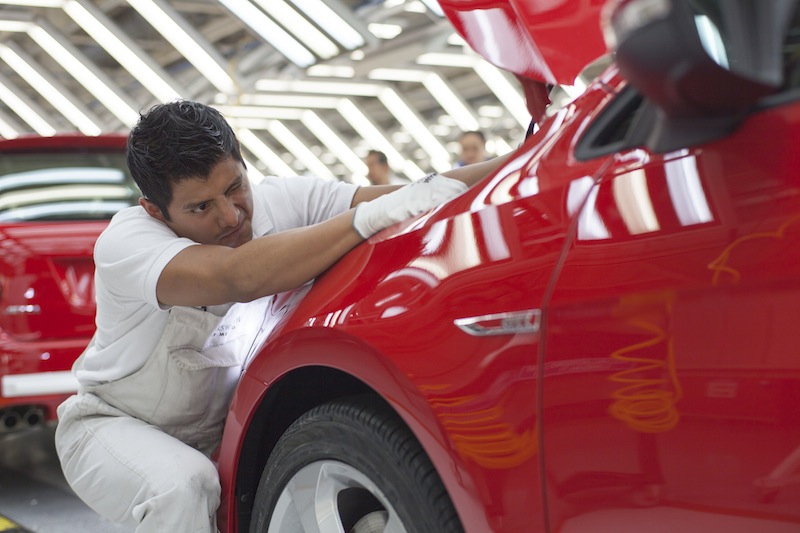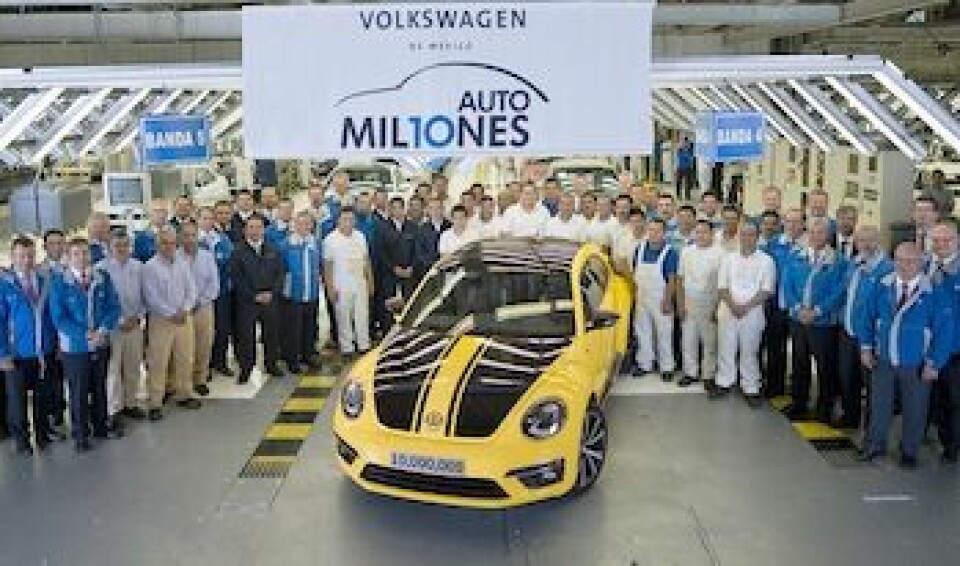Interview: Thomas Karig at VWdM

The vice-president of corporate affairs tells AMS how the OEM’s manufacturing complex at Puebla is still growing after five decades of production, with the addition of bodyshops for the new Golf and Tiguan
AMS: Which models is Puebla currently making?
Thomas Karig (TK): Puebla is producing the sixth-generation Jetta, which is our volume model – it’s more than 50% of our production; then the new Beetle in its second generation, both as a coupe as well as a convertible; and the Golf, which is the latest addition to the production here – starting last year – is the normal hatchback Golf and the variant, which is a station wagon. In the case of the Jetta and the Beetle, Puebla is the only plant where these cars are produced and from here they go to all world markets except China [FAW-VW Chengdu makes its own Jettas].
AMS: Can you give a figure for the output last year?
TK: Output last year was 475,000 cars.
AMS: How much of this output is for the local market and how much for elsewhere in North America?
TK: Roughly speaking, around half of our production goes to the US and Canada. Mexico is around 15% and the rest goes to all other countries: South America, Europe, most of the Asian markets.
AMS: That’s quite a large proportion going to the US.
TK: Yes, it makes sense because of the geographic location to build the important cars for the US market in Mexico. And especially Jetta – for many years the most-sold Volkswagen car in the US.
AMS: US consumers seem to like large cars, yet you are producing relatively small models here. Is the new three-row SUV, the Tiguan, an attempt to appeal more to that market?
TK: Well, there are two SUV projects. One is the larger SUV, which is going to be built in the US at the Chattanooga factory [which also makes the Passat]; and the smaller SUV, which is the Tiguan, that we are going to build here in Mexico, starting 2017, which is also in that sense a compact SUV and it is even based on the Volkswagen MQB [Modular Transverse Matrix] platform which is for the small, compact-car segment.
AMS: Is Puebla still one of VW’s largest exporters?
TK: Yes, and Puebla is in fact one of the largest assembly plants that Volkswagen has worldwide. And because of the special conditions that Mexico provides for the industry, not only closeness to the US market but also the possibility through the multiple trade agreements with North and South America, with the European Union, with Japan, to export duty-free to these markets, so Mexico has become a platform specifically for this kind of strategy. You cannot do that from any other country in the world.
AMS: Do you have a figure for the number of exports last year?
TK: It was about 85% [397,553 units].
AMS:
Volkswagen de Mexico celebrated its 50th anniversary last year. From a manufacturing point of view, how much has changed over the past five decades?
TK: Volkswagen has not changed once but many times over. Of course, 50 years ago the rationale to come to Mexico was to serve an emerging market – but really just emerging – and based on the legal situation that you were only allowed to sell cars assembled in Mexico; there was no import of cars, so you had to put [in] a factory [and] start developing a supplier network.
Then the company started to add other products [see timeline], but everything was focused on the Mexican market. But it already implied a very important technological change, adding a modern, front-wheel drive, water-cooled engine Golf to the rear-wheel drive, air-cooled engine Beetle. Then, at the end of the ‘80s, the decision was made to use Mexico to supply the US market. This wasn’t Volkswagen alone; other companies started to do so at that point in time. And again, this was a big change not only in production volume but also in attending to market requirements different from Mexico.
The next big change happened when Volkswagen decided to build the new Beetle in Mexico – production started in 1997 – and for the first time we were sending cars all over the world to Europe, to Asia, and this was again a big change in the business, to programme production to attend not only to two or three markets but to 100 markets with different requirements. A couple of years later, the decision was taken that all the Jettas would come from Mexico.
Every time you make a generational change of models, you introduce a lot of new technology, you have to change a big part of your production equipment, you have to retrain your workers [for] new technologies, so change is constant in terms of processes and also, of course, requires a big investment.
AMS: When you started serving all of these global markets, how did the required vehicle customisation affect production?
TK: That adds a lot of complexity to the operation, because literally no car is the same as the other one in the assembly line. You have to make sure that all the specific parts for this vehicle for this market, in terms of equipment, in terms of the engine, in terms of labelling etc are in place when the worker in the line has to assemble the car – and yes, this is a big challenge.
AMS: Production of the new Golf began last year. Are you manufacturing this model at the full capacity of 700 vehicles per day?
TK: No, right now we are at 550 a day.
AMS: What did the $700m investment for the Golf go towards?
TK: A big part of the investment went to a new bodyshop, because the design of the body of the new Golf has a lot of changes against the previous generation and is also different from the Jetta, so that was a big investment. The other big investment, as with every new model, goes to tooling that is going to be with our suppliers, in Mexico and elsewhere that make the specific parts for this model. In addition to many other changes that you have to do to the final assembly line itself.
AMS: Is the new body different because it is based on the Modular Transverse Matrix and its predecessors weren’t?
TK: Yes, in part. But especially one of the big objectives in designing the new car was to reduce its weight, and a lot of that comes from the body, it requires new kinds of steel, [to] ‘sophisticate’ the design of the body in order to achieve the weight reduction, which is very important for fuel efficiency and driving experience in general.
“Mexico provides… the possibility through multiple trade agreements with North and South America, with the European Union, with Japan, to export duty-free to these markets… You cannot do that from any other country in the world”
– Thomas Karig, VWdM
AMS: The Jetta and Beetle are moving to the MQB platform as well; what are the implications of MQB for equipment and tooling?
TK: MQB has an impact on the factory, as explained in the example of the bodyshop especially, but also for the supply chain. In the end what it does, once you have all the models on the same platform – not a good word for MQB but there is no easy translation from the German – once your whole range of products migrates to this system, there [are] going to be a lot of scale effects because your cars are going to share several modules, even [while] looking different for the customer; it will make the whole operation and also our suppliers more efficient.
AMS: A $1 billion investment at Puebla was announced in March – is that for the SUV, the Tiguan?
TK: Yes, that’s for the Tiguan – a long-wheel version, so the car will be a little larger or longer than the present Tiguan, which will allow us to include a third row of seats; and this is going to be especially important for the US market.
AMS: Has work begun on the expansion?
TK: Yes, the new bodyshop, again which is a big part of the investment, is under construction.
AMS: When will the work be completed?
TK: It has to be completed by mid-next year so we can start trials and start production [at the] beginning of 2017.
AMS: Is the new SUV the start of a trend of diversifying away from Golf-class vehicles?
TK: Yes and no! Yes, because definitely an SUV is a different type of car; no, because it’s part of the MQB strategy. So, even if the car looks very different, which of course requires a new bodyshop, it will share these efficiencies that the MQB platform provides. And it is a compact SUV; in terms of length and width, it’s not so far away from the cars we do today.
AMS: Looking at sustainability, how has VW’s Think Blue. Factory programme been applied at this plant?
TK: Well, we are part of the worldwide programme to increase energy efficiency [and] reduce impact on the environment by 25% by 2018. We have a big focus on water consumption; because of course water, as in many parts of the world, is an issue also in Mexico. We didn’t start with Think Blue, we had been working on these issues already before, but we have reduced water consumption by 50% in the last ten years. We have also been working on other issues like solid waste, for example. Today, this factory does not send waste to landfills; everything is recycled, reused, sold to somebody who is going to use it as basic material for something else. Those are just two examples.
AMS: Do you have any alternative sources of power, like solar?
TK: Not yet, but we have already signed a contract with a wind park in Mexico [in Zacatecas] which is going to start supplying wind-produced energy by the beginning of next year. Around 60% of the power consumption of the factory is going to be covered by this wind park.




